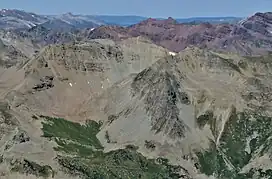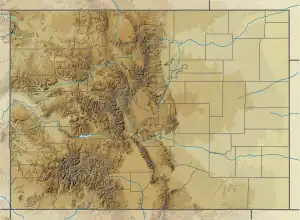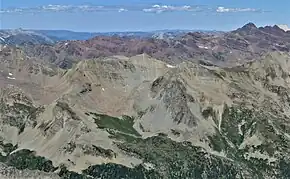| Hilliard Peak | |
|---|---|
 East aspect, centered, from Castle Peak | |
| Highest point | |
| Elevation | 13,422 ft (4,091 m)[1] |
| Prominence | 311 ft (95 m)[1] |
| Parent peak | Keefe Peak (13,532 ft)[1] |
| Isolation | 0.65 mi (1.05 km)[1] |
| Coordinates | 39°01′27″N 106°54′35″W / 39.0242105°N 106.9096509°W[2] |
| Naming | |
| Etymology | Edward Hobbs Hilliard, Jr. |
| Geography | |
 Hilliard Peak Location in Colorado  Hilliard Peak Hilliard Peak (the United States) | |
| Country | United States |
| State | Colorado |
| County | Pitkin County |
| Protected area | Maroon Bells–Snowmass Wilderness |
| Parent range | Rocky Mountains Elk Mountains[3] |
| Topo map | USGS Maroon Bells |
| Climbing | |
| Easiest route | class 2+[1] |
Hilliard Peak is a 13,422-foot (4,091 m) mountain summit in Pitkin County, Colorado, United States.
Description
Hilliard Peak is located 17 miles (27 km) west of the Continental Divide in the Elk Mountains which are a subrange of the Rocky Mountains. It ranks as the 306th-highest peak in Colorado.[1] The mountain is situated 12 miles (19 km) south-southwest of the community of Aspen and 2.8 miles (4.5 km) west-northwest of Castle Peak. The peak is set in the Maroon Bells–Snowmass Wilderness on land managed by White River National Forest. Precipitation runoff from the mountain's slopes drains into tributaries of the Roaring Fork River which is a tributary of the Colorado River. Topographic relief is significant as the summit rises 2,800 feet (853 m) above Conundrum Creek in 1.3 miles (2.1 km) and 2,400 feet (732 m) above East Maroon Creek in 1.2 miles (1.9 km).
Etymology

The mountain's toponym was officially adopted on December 9, 1975, by the United States Board on Geographic Names to commemorate Edward H. Hilliard, Jr. (1922–1970), conservationist and environmentalist.[2] He was born in Louisville, Kentucky, on October 16, 1922. He served as an Infantry Lieutenant in France during World War II, then completed his college education at Yale University in 1948, then moved to Colorado in 1949.[4] Hilliard died on August 15, 1970, when he and a climbing companion were killed by a rockfall near the summit of North Maroon Peak.[5]
Climate
According to the Köppen climate classification system, Hilliard Peak is located in an alpine subarctic climate zone with cold, snowy winters, and cool to warm summers.[6] Due to its altitude, it receives precipitation all year, as snow in winter, and as thunderstorms in summer, with a dry period in late spring.
See also
 Mountains portal
Mountains portal- Mountains of Pitkin County, Colorado
- Thirteener
References
- 1 2 3 4 5 6 "Hilliard Peak - 13,422' CO". listsofjohn.com. Retrieved May 16, 2023.
- 1 2 "Hilliard Peak". Geographic Names Information System. United States Geological Survey, United States Department of the Interior. Retrieved May 16, 2023.
- ↑ "Hilliard Peak, Colorado". Peakbagger.com. Retrieved May 16, 2023.
- ↑ Edward Hilliard, Jr. Papers, Denver Public Library, Western History and Genealogy
- ↑ Andrews D. Black (1971), Edward H. Hilliard, Jr., 1922-1970, americanalpineclub.org
- ↑ Peel, M. C.; Finlayson, B. L.; McMahon, T. A. (2007). "Updated world map of the Köppen−Geiger climate classification". Hydrol. Earth Syst. Sci. 11. ISSN 1027-5606.
External links
- Hilliard Peak: weather forecast
- Edward H. Hilliard in memoriam: Americanalpineclub.org